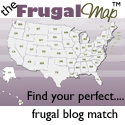I have a semi-completed price book that has definitely helped in tracking the sales. It can be a process to start one up but it is an invaluable tool! The most important part of making a truly useful price book is having consistent unit prices for the products you choose to track. You can use the unit pricing the stores post on the shelves, but they will not always use the same calculations! (see this article on whether your TP is a good deal - thanks to Grocery Cart Challenge for digging up that gem!) You may find that the same item is priced out by the gallon at one store, by the liter at another, by the ounce at a third. Choose unit measurements that work for you - I use ounces for liquid, and pounds for most dry goods. I like Diane's method of pricing paper goods by the square footage! Tipnut has this great printable measurement conversion chart that I've used before, and this online conversion tool has also come in handy. The most important thing is to keep your unit of measure the same!
Price of item/total volume or weight = cost per unit of measure
Be sure to make any conversions in measure (liters to ounces, ounces to pounds, etc) before you figure out the unit price, so that everything stays consistent.
Think you really know whether your ground coffee is a good deal just because the price hasn't changed in 10 years? Check out this article by FrugalDad on how companies changed the package sizes when the economy got tighter and what we are really getting for our money.
Since fresh items are already priced by the pound, I found it's easier to set basic guidelines for good pricing, so that when sales hit the "sweet spot" or lower I know to stock up! I have watched the sales in my area and here's what I go by:
Fresh meat, bone-in - $1.00/lb or less
Fresh fruits and vegetables, loose - $0.99 - 1.29/lb for most
Fresh fruits, container - $2.00/container or less
Your area may average a little higher or lower, but I can get just about any type of meat (including sausages, kielbasa and prepared meats) and all produce at these prices or less during various points of the sales cycle.
Some folks choose to include coupon pricing with their unit price tracking - I find that since the coupon amounts vary so much it's hard to use that as a good starting point. By tracking the regular sale prices of items without coupons, I know when a name brand will be cheaper than a generic with a coupon.
It definitely takes a little effort, but keeping track of best prices can save HUNDREDS of dollars a year depending on how many mouths you are feeding. And as everyone's belt gets a little tighter, making every penny count becomes worth the work!



 Stumble It!
Stumble It! 

















No comments:
Post a Comment